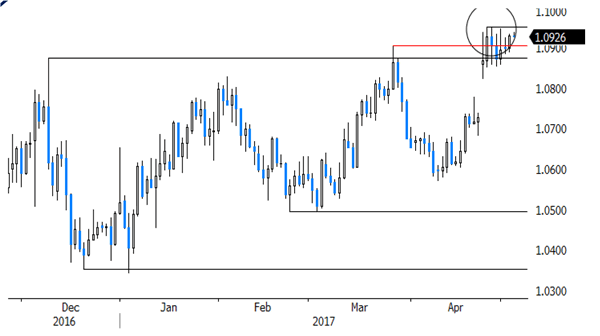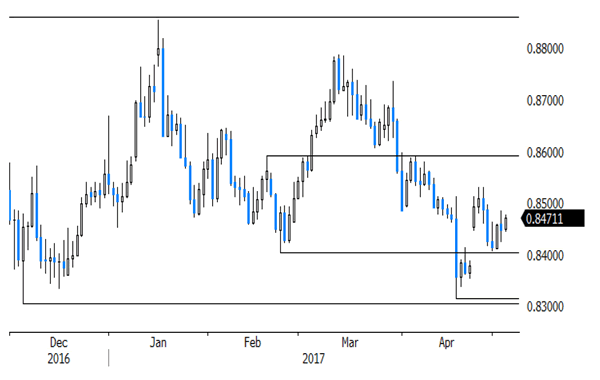Sunrise Market Commentary
- Rates: Upward bias US Treasuries, outperforming German Bunds?
Risks for US eco data are on the downside of expectations. Overnight future trading suggests that US equity markets are prone for a downward correction. Oil prices are on the verge of breaking below key support with EIA data scheduled for release. This combination suggests an upward bias for US Treasuries, especially if the Fed is (too) cautious in its statement. - Currencies: Dollar still struggles going into the FOMC decision
Yesterday, the dollar showed a mixed picture, but in the end the US currency closed near the recent lows against the euro and failed to take out a first resistance against the yen. Today, the eco data might be euro supportive and slightly USD negative. Will the Fed’s policy statement be strong enough to give the dollar the highly needed interest rate support?
The Sunrise Headlines
- US stock markets traded narrowly mixed ahead of Apple earnings. Nasdaq futures are lower overnight on mixed Apple results. Risk sentiment on other Asian markets is mixed, with Japan and South Korea closed.
- Apple extended its rebound in the latest quarter with rising profit and revenue, but reported tepid iPhone demand that adds pressure on the technology giant to deliver a hit with its new 10th-anniversary handset later this year.
- The latest Republican effort to reshape the nation’s health-care system teetered on the brink of collapse in the House, reflecting a new assertiveness by GOP centrists, a group that in recent years has rarely wielded such power.
- The EU has raised its opening demand for Britain’s Brexit bill to an upfront gross payment of up to €100B, according to Financial Times analysis of new stricter demands driven by France and Germany.
- Ford and General Motors have both reported steeper-than-expected declines in US car sales in April, underscoring fears that the market is cooling faster than anticipated after peaking last year.
- Crude oil prices bounced back on Wednesday as a decline in US inventories underpinned the market. They still closed more than 1% lower though as a dip in compliance with OPEC efforts to reduce output and near record supplies capped gains.
- Today’s eco calendar heats up with the FOMC meeting, ADP employment report, German employment data and EMU Q1 GDP. Germany sells bonds and ECB Hansson is scheduled to speak
Currencies: Dollar Still Struggles Going Into The FOMC Decision
Fed to decide on ‘USD rebound’
There were few eco data with potential to move the euro or the dollar yesterday. Especially EUR/USD held a tight range in the low 1.09 area. Greece’s agreement with international creditors and hawkish comments of ECB Nowotny couldn’t help the euro. Late in the session EUR/USD drifted slightly higher on USD softness to close the session at 1.0930. USD/JPY tried to regain 112.20 resistance as risk sentiment remained constructive, but the pair returned to the 112 area as US yields lost a few bps later in the session. This move was at least partially driven by a decline of the oil price.
Overnight, several Asian markets including Japan are closed for regional holidays. Mediocre earnings from Apple published after the close yesterday weigh on Asian sentiment. USD/JPY hovers in the 112 area. EUR/USD trades in the 1.0935 area. So, the recent highs are again within reach as investors count down to the Fed’s policy decision. The New-Zealand employment/unemployment data were stronger than expected, but wage data remained relatively soft. The kiwi dollar initially gained modestly ground after the publication of the release, but most of the intraday gains already evaporated. NZD/USD trades again near 0.6950.
Today’s eco calendar contains the US ADP employment report (consensus: 175K), the non-manufacturing ISM (55.8 from 55.2) and the EMU Q1 GDP (expected 0.5% Q/Q & 1.7% Y/Y). After two exceptionally strong ADP reports, there is room for some payback. We see downside risks for the services ISM as well after a disappointing manufacturing ISM. Risk for the Q1 EMU GDP are balanced. a strong German GDP is needed to reach the 0.5% Q/Q, The FOMC is widely expected to keep its policy rate unchanged (0.75%-1%). In the Fed statement we don’t expect a real policy shift. The statement will keep the possibility of a June hike (and another rate hike this year) intact. Will the Fed downplay Q1 growth? Later this week, the Fed governors will speak out, which may give us a better take on the outlook for policy. Q2 GDP should rebound and inflation moved already to the 2% threshold (if not in Q1 GDP deflator terms). The Fed most probably continues the discussion on balance sheet tapering, but it looks too early to already receive an action plan. Markets will be sensitive to these issues, but these might only be tackled when Fed speakers appear Friday
In a daily perspective, the focus will be on the Fed statement. If the Fed elaborates on recent US data softness, it might be a slightly USD negative, even if the FOMC keeps the option of a June rate hike open.
The intraday developments/factors (EU and US data, soft oil price, modest equity correction?…..) are probably also a slightly negative for the dollar. In this context, the Fed will have to sound quite convincing on its future rate hike intentions to support the dollar. We are not convinced that the dollar will get enough interest rate support right now. We don’t expect a USD sell-off, but EUR/USD might test and even (temporary ?) regain the 1.0950 area. In this context, it also won’t be easy for USD/JPY to regain the 112.20 area in a sustainable way.
Last week, FX trading was driven by the risk trade as European event risk eased. This supported USD/JPY, but also EUR/USD and EUR/JPY. The market pondered whether declining political risk could bring forward the ECB’s normalisation process. This hope was moderated after the ECB press conference. From a technical point of view, the rebound of USD/JPY suggests a bottoming out process has started, but the pair needs to regain the 112.20 level (neckline ST double bottom) to improve the picture. A first test yesterday didn’t succeed yet. EUR/USD extensively tested the topside of the MT range (1.0874/1.0906 area) late March. The pair returned to the range top after the French election and set minor new highs. We look out how this test turns out. If EUR/USD regains the 1.10 barrier, next resistance comes in in the 1.1145/1.13 area (US pre/post-election swings).

USD: holding near the post-Macron-top. Fed to decide on ST break higher?
EUR/GBP
Sterling to become more sensitive for Brexit headlines?
Yesterday, sterling remained under pressure early in Europe as the harsh comments from EU commission President Juncker on the Brexit negotiations continued to weigh on sterling. Mid-morning, the UK April manufacturing PMI came out surprisingly strong at 57.3 from 54.2 in March. Initially, the gains of sterling remained very modest, but the UK currency gradually received a better bid later in the session. EUR/GBP closed the session at 0.8448. Cable regained the 1.29 level and closed the session at 1.2939.
Today, UK construction PMI is expected to decline slightly from 52.2 to 52.00. This morning, sterling is again trading with a slight negative bias on Press headlines that the EU will take a tough stance on the UK financial obligations at the start of the Brexit negotiations. So, as was the case earlier this week, there are tentative signs that Brexit uncertainty is gradually becoming a bit more important for sterling trading. A more cautious sentiment on risk might also be slightly negative for sterling. On the other hand, EUR/GBP might be supported by some overall euro strength. Will this be enough for EUR/GBP return to the 0.85 barrier today?
Two weeks ago, EUR/GBP dropped below EUR/GBP 0.84 support, (temporary) improving the sterling picture. The pair came within reach of the key 0.8305 support (Dec low), but no real test occurred. After last week’s EUR/GBP rebound, the range bottom is better protected. Longer term, Brexit-complications remain potentially negative for sterling. On technical considerations we are inclined to reconsider a cautious EUR/GBP buy-on-dips approach

EUR/GBP: downside better protected after last week’s rebound












